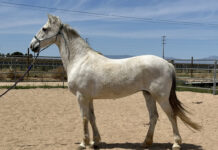
Additionally, the KyEHC receives many horses that have emotional issues due to abandonment, neglect or injury. Neagle says they can be aggressive, scared of people or even completely feral. When Gilbert, a Quarter Horse stallion, was brought to the center by animal control in February 2007, he was terrified of humans to the point that he would lie down when someone approached him.
“We try to handle them every day,” says Neagle. “It’s a matter of getting their trust and trying to figure out what their issues are and working through them.”
In addition to his fear, Gilbert was severely emaciated. In these situations, the KyEHC relies entirely on the advice of the veterinarians who donate their time to care for the horses at the center. Tom Daugherty, DVM, of Advanced Equine Veterinary Practice, oversees the veterinary care at the KyEHC.
“The [emaciated] horse needs a complete physical to find out if there are any internal organ problems—liver or kidney disease—or a metabolic abnormality that needs to be corrected,” says Daugherty.
One of the problems that will often show up during this exam is a heavy parasite infestation.
“Wait to deal with the parasite load until proper feeding is initiated, which is necessary to avoid inducing organ failure,” says Lori Bidwell, DVM, DACVA, of Rood and Riddle Equine Hospital, who is on the KyEHC Board of Directors. “Treatment for parasites should be withheld until approximately 40 days after the initiation of care.”
From that point on, much of the rehabilitation process is focused on strategic feeding. Daugherty points out that many emaciated horses have a severe calcium deficiency. He starts these horses on two to four flakes of alfalfa hay each day for several weeks.
“Horses are calcium wasters, so they’ll take in as much calcium as they need and then excrete the rest of it,” says Daugherty. “That will allow them to build up their muscle mass and repair any bone loss. It also brings their body back to proper condition.
“The protein in the alfalfa will help them feel better and want to eat more,” continues Daugherty. “Feeding a lot of concentrates to get them to gain weight can cause a lot more metabolic issues.” After about two months, the alfalfa can be slowly phased out while grass hay and small amounts of grain can be introduced and increased over time.
Bidwell stresses that the process of introducing feed to an emaciated horse should be very gradual. “It may seem like a diet of concentrated calories would be helpful, but it can actually result in organ failure—this is called Refeeding Syndrome,” she says. “Although emaciated horses have a strong interest in eating, their health may actually get worse after initiating feeding.”
Severely emaciated horses tend to have major dental issues as well. According to Daugherty, the appropriate time to address these problems is after these horses have put on some weight and are showing signs of improvement.
The most important consideration to keep in mind when rehabilitating emaciated horses is that you can’t expect them to turn around overnight. “It took a long time for them to get to an emaciated state, and it’s going to take a long time to bring them back,” says Daugherty, noting that it could take up to a year to improve the body condition of an extremely thin horse.
Tough Decisions
When Neagle, Daugherty and the KyEHC staff are caring for horses with these physical and emotional problems, the most difficult decision they have to make is whether or not to euthanize.
“It has to be a case where they are in pain and there is nothing we can really do to help them—when surgery is not an option, or if it is an option but the likelihood that they will recover and be sound isn’t good,” says Neagle.
After reviewing a horse’s physical exam, taking into consideration the severity of any lameness issues, and a behavioral assessment, Neagle, Daugherty and the KyEHC staff look at the horse’s chances of recovering and being adopted.
For those horses that are able to move on to new lives, the people who adopt them need to be prepared to provide them with extra care.
“Adopters need to be cautious with these horses,” says Daugherty. “Try to gain their trust. [They need to know] that they’re going to be fed on a regular basis, and that they don’t need to shy away from the person who’s feeding them or the vet who’s trying to take care of them. A lot of those horses are in pain, and any time they get touched, they feel like it’s going to be more pain for them.”
Bidwell suggests separating a rescue horse from other animals for one to two weeks. “Use patience and caution when handling these horses, as their responses to what might seem to be normal may be unpredictable,” she says. “Many of these horses can flourish after proper care. If you plan to use a rescue horse for riding, be sure to have him properly evaluated for lameness prior to beginning an exercise or training regimen.”
This article originally appeared in the July 2009 issue of Horse Illustrated. Click here to subscribe.
Back to Diary of a Horse Rescue





